The content of the article
Seasonal molting of pets gives a lot of trouble to their owners. The apartment has to be cleaned much more often. Wool spreads throughout the apartment. She sticks to clothes, carpet, even gets into food. This is not entirely pleasant, but the owners who adore their pet suffer such inconvenience, and even look at it with emotion.
But sometimes a cat begins to molt for no reason. She has bald patches, which causes concern and confusion among the owners. The causes of this symptom can be many. Without even going too deep, they can be listed about 20. Consider the most common ones, which we can not guess about.
Deviation or norm?
It is very rare that a cat does not experience problems with hair loss throughout its life. This is especially true of thoroughbred animals. With ordinary cats, things are somewhat different, as they have stronger immunity. But they may also have similar problems due to non-compliance with the rules of detention or for other reasons.
The coat of a cat can fall out not only due to any disease. This can happen as a result of a stressful situation or age-related changes.
Consider the possible causes depending on the severity.
Reasons you shouldn’t panic
Scarring
This may be due to a vaccination or injection. The animal loses its hair, and it can no longer grow in this place. After vaccination or injection it is necessary to examine the skin of the cat. Pustules or scales may form at this site.
Scarring is manifested in the form of thickening of the skin. Abscesses or inflammation may occur. Sometimes it leads to itching or fever.
If the injection site turns red and the animal constantly scratches it, then it is necessary to isolate the area so that the cat could not scratch it, and give an antihistamine. If the temperature rises, you need to consult a veterinarian at least by phone.
Age-related exhaustion
This usually refers to the hair around the eyes and ears. If, in addition to thinning the coat in this area, there are no longer any suspicious signs, then there is no reason for excitement.
Pregnancy and lactation
During this period, the cat may lose a significant part of its coat. In some places she can even lose her hair. Often, lactating cats develop bald patches in the area around the nipples. To bring the cat's hair back to normal, she needs to add vitamins to her food. And the nutrition of the nursing cat must be complete.
Hypotrichosis
This problem will already be visible in the kitten. He is born with a small amount of hair, which usually falls out completely by 4 months. This is a genetic abnormality. The only way you can help your pet is to provide him comfort and warmth.
Moderate causes
Food allergy
This problem can occur not only in humans, but also in pets. At the same time, a cat that is used to eating milk, meat and fish can develop an allergy even to these products familiar to her.
In allergic reactions to products in cats, wool begins to fall out in places. Ears may become inflamed, itching may begin. Sometimes a pet's body temperature rises. To determine the cause, you must show the animal to the veterinarian. The cat as a result becomes nervous, itches and washes more often than usual.
To get rid of the problem, it is necessary to determine which products the cat has developed an allergic reaction to. This can be done by remembering what new products you gave your pet. The source of the reaction can only be determined by the sample method. It is also necessary to exclude products that can cause a similar reaction.It can be smoked meats or poor-quality store food.
Congenital atopy
This is the same allergy, but not to food, but to substances that the animal inhales. In this case, the pet has the same symptoms. It is determined using a biopsy and a blood test. Such a reaction may be caused by pollen from certain plants, mold or dust.
Contact dermatitis
This problem is also a type of allergy, but the reaction manifests itself in a more serious and severe form. In this case, allergens may be substances such as antibiotics, metals, polymers, plants that produce toxic substances or household chemicals.
If the pet has thin coat, redness and even blisters may appear on the skin. If the cat has a long thick coat, then it will start to fall out quickly and intensively. In an animal that is constantly in contact with a source of allergy, hair can fall out in shreds. In addition, itching develops. Sometimes it becomes difficult for the animal to breathe.
In order to rid a pet of such suffering, it is necessary to detect by test method which particular substance such a strong reaction is observed. If you can’t determine it, you can make tests to help you find out the cause. Severe allergies are treated with steroids and atigistamines.
Parasite bite response
This reaction is not common. It can occur in young cats or in cats aged. In the place of the bite, a seal appears, wool falls out. In the area of the body, the temperature may rise, the pet scratches the place of the bite.
If your pet suffers from such a problem, you must carefully monitor that his parasites do not start.
Lichen
This infection can be caused by ticks or fungi. The hair of the animal begins to fall out intensively, scales form, the skin becomes dry.
Treatment in this case is prescribed by the veterinarian. It is important to be careful, as households risk getting infected from their pet. Having identified the problem, you must immediately begin treatment. It is better to burn the cat litter and exchange it for a new one, and disinfect it in the house.
Severe illness
Demodecosis
The first symptoms are the same as with lichen. The diagnosis can only be made by a veterinarian after testing. It is impossible to cure this disease on your own. On the back of the animal, hair begins to fall out. If a cat's immunity drops, these bald patches can turn into wounds. Combing and exposure to water can cause the same reaction.
To identify problems, you must consult a veterinarian. He will do the tests. This problem is quite common, so many veterinarians easily determine it. If the wounds get wet and bleed, then they are treated with drying preparations. If the cat scratches the wounds, then this will lead to complications. Therefore, with such a problem, it is recommended to wear an animal cap.
Seborrhea
Such a problem may arise due to a previous illness, exposure to parasites or to be congenital. Seborrhea can be easily confused with other diseases. Therefore, it can be determined by making laboratory tests.
The cat's skin is peeling, the coat is either too dry or oily. Itching is observed, in some areas baldness.
Adenitis
This problem is hereditary. It can manifest itself in a young pet or already elderly. The cat’s sebaceous glands become inflamed, failures occur in their work. When the disease is just beginning to develop, the cat's hair becomes brittle. In the area of the head, ears and neck, it begins to fall out. In addition, there is a symptom such as dandruff. Crusts and flakes form on the skin. The bald patches are rounded. The pet scratches the affected skin. Sometimes an unpleasant odor can come from the affected area. If the disease is not treated, then it spreads along the back of the animal up to the tail.Over time, the scales begin to become wet, become yellowish or grayish. In advanced cases, the animal begins to itch more and more, which can lead to the formation of bleeding wounds.
With such a problem, it is necessary to consult a specialist without fail. Many cats' skin problems causing hair loss are similar. That is why it is necessary to show your pet to the veterinarian. Only he can determine the true cause. The sooner you determine the causes of your pet’s suffering, the sooner relieve them.
Cushing's Syndrome
This disease is caused by an excess of corticosteroids in the blood. It can occur for physiological reasons or as a result of treatment.
The symptom is hair loss, the skin is thinning. The animal is constantly thirsty, as a result of which there is frequent urination. The peritoneum of the pet increases. In addition, signs of seborrhea appear.
The vet will prescribe a pet urine and blood test. This problem cannot be treated on its own. To get rid of it, you must strictly follow the instructions of a specialist.
Hyperteriosis
In cats, thyroid function malfunction may occur. As a result, some hormones are released incorrectly. The cat is often washed, there is seborrhea. Even if you pet your pet lightly, hair begins to fall out.
If the veterinarian suspects that this problem is the cause of hair loss, he appoints an analysis that will determine the level of hormones. If suspicions are confirmed, treatment is prescribed. Treatment is carried out with medication or surgery.
As a result, we can say that there can be many reasons for hair loss in a cat. They can be both harmless and dangerous to the animal. Therefore, if a problem occurs, you should contact a specialist.
Video: how to deal with molting in cats?





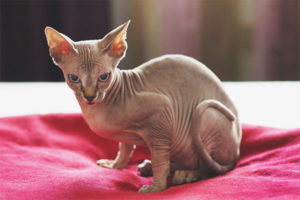
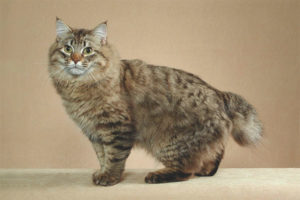
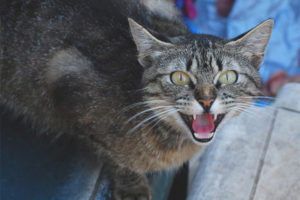
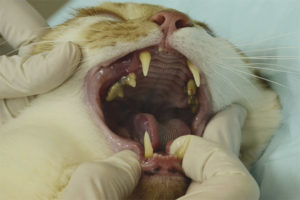
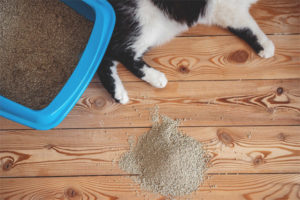
Submit